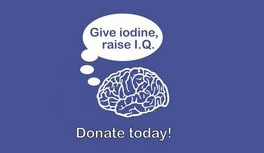Iodine Global Network (IGN)
Sprunglinks/Accesskeys
Zur Startseite (Accesskey 0) Direkt zur Hauptnavigation (Accesskey 1) Direkt zum Inhalt (Accesskey 2) Kontakt (Accesskey 3) Sitemap (Accesskey 4) Suche (Accesskey 5)
DONATE

8. How do we provide iodine to a deficient population?
Iodized salt
Salt is the best vehicle for adding iodine. Everyone needs salt, everyone eats it, usually in daily amounts, and the technology for iodization is straightforward. It can be added as potassium iodide or potassium iodate; the latter is preferred under conditions of humidity or impurities because of its greater stability.Most countries have regulations calling for 20-40 mcg iodine/g of salt (20-40 ppm); thus if an individual eats 5 g of salt iodized at 30 ppm, she gets 150 mcg iodine from this source alone. The amount to be added varies for particular populations, depending on the amount of salt ingested, the purity of the salt (and therefore, the amount lost between production and consumption), and the amount of iodine ingested from other sources. In some countries, when daily salt intake decreases, the health authorities raise the amount of iodine in the salt, to provide a constant adequate daily amount.
Iodized oil
Another method for providing iodine to a community is through the administration of iodized vegetable oil. These preparations, e.g., Lipiodol, were developed as an X-ray contrast medium. One milliliter (one-fifth of a teaspoon) contains about 480 mg of iodine. A single administration orally provides adequate iodine for about a year, and if given by intramuscular injection, it is satisfactory for about three years. Iodized oil is most useful when the iodine deficiency is severe, when immediate correction is important, and when iodized salt is not yet available.Other vehicles
Drinking water is another occasional vehicle for iodine nutrition. Some systems slowly release iodine from a porous basket (containing a concentrated iodine solution) into well water. Another approach adds an iodine solution to water in a well or flowing through a pipe. A simpler version merely adds a few drops of a concentrated solution manually to vessels containing drinking water in a school or home. If iodine (I2) is added, it can also sterilize the water; this property is useful because many regions with iodine deficiency also have contaminated food and water.Occasionally, iodine is given as tablets of potassium iodide, from 100 to 300 mcg per day or about 1 mg per week. Some vitamin/mineral preparations for daily use contain 150 mcg iodine, the recommended amount.
Other vehicles like sugar, bread, and tea have been occasionally used for iodine delivery. However, the many advantages of iodized salt make it the overwhelming favorite for most countries.
